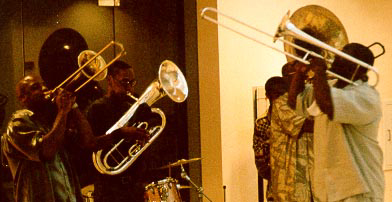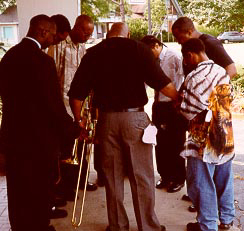
Kenny Carr and the Tigers:
An Introduction to Pentecostal Brass Shout Bands
by Craig Kridel, University of South Carolina
"The Shout Bands of the southeastern United States are a little known treasure. . . . The foremost of these is The Tigers, a group of talented musicians from Charlotte, North Carolina, a hotbed of Shout Bands." (Hafar, 2001)
Kudos to conference director Dennis AsKew for scheduling a traditional brass shout band at the ITEC! Few musical genres better represent this area of the country, and few visitors to the Carolinas have such an opportunity to hear this wonderful and rare form of brass music. Those who attended this very special session on Saturday afternoon were able to witness a music form that rarely is presented on the concert stage. While other shout bands reside in New York City, Washington DC, Newport News, VA and Savannah (Smithsonian Folkways, 1999), I most certainly concur with Dr. Mathew Hafar. None surpass Kenny Carr and the Tigers in terms of their musical virtuosity, sophisticated sound, and polished stage presentation.
With its sousaphone and baritone, the trombone shout band is representative of the worship services of the United House of Prayer, a Pentecostal denomination common on the east coast and quite active in the Greensboro, Winston Salem, and Charlotte areas of North Carolina. "Shout" describes the singing style and form of worship in many African American religious denominations. The "ring shout" -a type of movement-has been a feature of worship throughout the 19th and 20th centuries and is coupled with the act of testimony as a basic element of religious service. Many African-American Pentecostal denominations stem from the emotional Holiness Revival of the late nineteenth century when African American religious leaders renounced the staid, stoic ways of formal religion and believed salvation rested with an emotional form of worship. Speaking to God, through the "shout," offered the direct experiences and the emotional touch of the Spirit.
The shout band style is up tempo, duple meter, bright, responsive to the congregation, and incorporates a chordal wall of sound as players form a semi circle with the leader playing and directing in front. The musical form consists of three sections. The recitative, played by the lead trombone in a slow improvisatory manner, constituting a "call" for which the row tenor trombones play a fundamental chord progression. The second section, described by Damon (1999) as the aria, establishes tempo and sets the melody through repeated and then ornamented verses. The third section is "the shout," with a call response pattern and a rhythmic cadence called "backtimin" or "polin" where the sousaphone, playing a walking bass line, provides the foundation for hocket and hemiola rhythms. The length of the sections are determined by the lead trombone who is responding to the congregation. Bands move from section to section from the leader's gesture, known as a "rise"-either a melodic or physical cue. With a rapid vibrato intensifying during the shout, the band's dynamics typically begin with a pianissimo during the recitative, a slow crescendo through the aria, and a dramatic crescendo (called "thundering") through the shout with the lead trombone and the second trombone, known as the "run man" or "chaser horn," improvising counter-melodies and rhythms. Shout bands may play continuously for up to three hours at religious services.
Why the trombone emerged as the instrument of choice is unclear; actually, early bands, circa the 1920s and 1930s, included any available instruments; however, the trombone has enjoyed close association with the African American church, most notably in James Weldon Johnson's God's Trombones, written in 1927. The first documentation of a trombone in the shout band is from the late 1930s (in Columbia, SC). This date can be contested since Kenny maintains that Abe Miles of Charlotte hosted the first trombone shout band in the 1920s (Carr, 1999). George Holland of Newport News, is also credited with introducing the trombone as the dominant instrument of shout bands. Robert Washington, also of Newport News, is known for introducing the Sousaphone.
The Tigers, formerly the number one band of the Charlotte United House of Prayer, are now multi denominational and play in a variety of church, festival, school, and concert settings. Founded in 1956, the Tigers have been featured on NPR's All Things Considered as well as having shared the stage with Gladys Knight, Ramsey Lewis, Jonathon Butler, to name just a few performing artists. Tigers performing at ITEC included Kenny Carr, Mark Dixon, Ronnie Durham, James Harrison, trombones; Preston Kelly, baritone; Zeb Harrison, tuba; with Jeff Elmore on drums. The Tigers are interested in presenting their music to new audiences; they may be contacted at kc7music@hotmail.com
References
Carr, K. (1999). Oral interview with C. Kridel, April 22, Charlotte, NC.
Carr, K. et. al. (1998) Make a Joyful Noise: Sound that Shout Band Brass CD recording. Right Lane Productions TRRL991. Available at http://www.cdbaby.com/cd/tigers/from/iuma; please note: this is the only authorized recording by Kenny Carr and the Tigers; other Tigers recordings exist but do not represent this ensemble.
Damon, S. (1999). The Trombone in the Shout Band of the United House of Prayer for All People. D.M.A. dissertation, University of North Carolina, Greensboro.
Hafar, M. (2001). "Shout Bands of the Southeastern United States," Historic Brass Festival Conference, June 30. Wake Forest University, Winston-Salem, NC.
Smithsonian Folkways. (1999). Saints Paradise: Trombone Shout Bands from the United House of Prayer CD recording. Smithsonian Folkways Recordings CD 40117.Original publication: Craig Kridel, “Kenny Carr and the Tigers: An Introduction to Pentecostal Brass Shout Bands,” International Tuba & Euphonium Association Journal 30:1, Fall 2002, 64-65.
early 19th century brass

